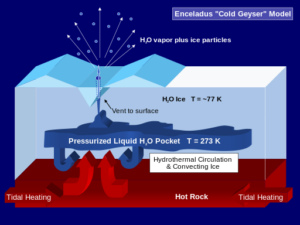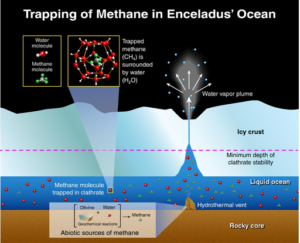What two causes of volcanism have been identified for solar bodies?
While Earth’s volcanism is generally related to movement of its tectonic plates, or to specific hot spots in its mantle (mantle plumes), igneous volcanism and cryovolcanism of a solar system body have been related to heating up of interior elements by gravitational tidal action, or light, to create steam or gas expansion pressure which is released through vents.

Image attribution: Image attribution: By cflm [GFDL (http://www.gnu.org/copyleft/fdl.html) or CC BY-SA 3.0 (http://creativecommons.org/licenses/by-sa/3.0)], via Wikimedia Commons

Image attribution: By NASA/JPL-Caltech/SwRI (http://photojournal.jpl.nasa.gov/jpeg/PIA19059.jpg) [Public domain], via Wikimedia Commons
Tidal action (by pull of gravity)
Instead of erupting molten rock, as in a conventional volcano, cryovolcanoes erupt volatiles (low boiling point elements or compounds), like water, ammonia, carbon dioxide, nitrogen, or methane, accompanied by gas-driven solid fragments. This is called cryomagma. A cryovolcano produces plumes that may be a hundred or more degrees hotter than the frozen surface matter. Exposed to the cold and vacuum of space, the plumes quickly solidify, becoming airborne dust. As the gravity is weak on many ice moons, the plume may completely escape the moon’s gravity well, go into an orbit, or crash back down on the surface in another area.
The source of energy of a cryovolcano usually comes from tidal friction, heat that builds up in the core of moons as they bend and distort in the gravity field of the massive gas giants they orbit.
Source: See the rest of this article at wisegeek.com.
Greenhouse effect (by light penetrating a translucent surface).
It is also suspected that some moons may have translucent layers of ice that permit light in to heat material beneath it, but have an insulating property that seals in heat and creates a greenhouse effect. This creates pressurized gases in the interior that will escape if there is a route to the surface, thus creating a cryovolcano.
Source: Wisegeek.com.
Pluto’s cryovolcanism may be of this second “light-activated” type.
The energy required to melt ices and produce cryovolcanoes was thought to come from tidal friction, but recent observations of Pluto have shown that tidal forces are not required for small, icy worlds to have geological activity. It has also been suggested that translucent deposits of frozen materials could create a subsurface greenhouse effect that would accumulate the required heat.
To see which moons have been found to have cryovolcanos, and a video of one way water ice can freeze quickly, see the next page.



